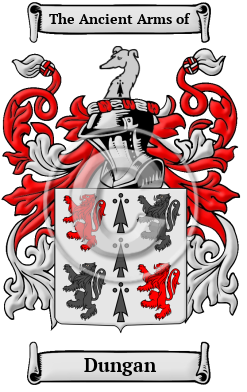| ![Show Contents]() Dungan History, Family Crest & Coats of Arms Dungan History, Family Crest & Coats of Arms
- Origins Available:
Ireland
Etymology of DunganWhat does the name Dungan mean? The Irish surnames in use today are underpinned by a multitude of rich histories. The name Dungan originally appeared in Gaelic as Ó Donnagain. The first portion of the name is probably derived from "donn," which means "brown," while the second portion of the name is probably derived from and ancient Irish personal name. 1 Early Origins of the Dungan familyThe surname Dungan was first found in County Cork (Irish: Corcaigh) the ancient Kingdom of Deis Muin (Desmond), located on the southwest coast of Ireland in the province of Munster, where they held a family seat at Muskerry, later moving to Limerick, Kildare and Dublin. Early History of the Dungan familyThis web page shows only a small excerpt of our Dungan research. Another 114 words (8 lines of text) covering the years 1172, 1300, 1395, 1412, 1413, 1634 and 1715 are included under the topic Early Dungan History in all our PDF Extended History products and printed products wherever possible. Dungan Spelling VariationsBecause early scribes and church officials often spelled names as they sounded, a person could have many various spellings of his name.Many different spelling variations of the surname Dungan were found in the archives researched. These included Donegan, Donnegan, Doneghan, Donneghan, Donagan, Donnagan, Donnaghan, Dunnegan, O'Donegan, O'Dunnegan, O'Donnaghan, Dongan, Donegin, Donnegin, Donnagen, Donagen, Donnegen, Donegen, Donnigan, Donigan, Dunnican, Dunican, Dunnigan, McDunnigan, McDonegan, Dongane, Dongin, Dongen and many more. Early Notables of the Dungan familyJohn Donegan (died 1413), a medieval Manx prelate. After holding the position of Archdeacon of Down, he held three successive bishoprics, Mann and the Isles (Sodor), then the see of Derry and then, lastly, Down; and...
Another 36 words (3 lines of text) are included under the topic Early Dungan Notables in all our PDF Extended History products and printed products wherever possible. Dungan Rankingthe United States, the name Dungan is the 8,657th most popular surname with an estimated 2,487 people with that name. 2
| Dungan migration to the United States | + |
In the 18th and 19th centuries, thousands of Irish families fled an Ireland that was forcibly held through by England through its imperialistic policies. A large portion of these families crossed the Atlantic to the shores of North America. The fate of these families depended on when they immigrated and the political allegiances they showed after they arrived. Settlers that arrived before the American War of Independence may have moved north to Canada at the war's conclusion as United Empire Loyalists. Such Loyalists were granted land along the St. Lawrence River and the Niagara Peninsula. Those that fought for the revolution occasionally gained the land that the fleeing Loyalist vacated. After this period, free land and an agrarian lifestyle were not so easy to come by in the East. So when seemingly innumerable Irish immigrants arrived during the Great Potato Famine of the late 1840s, free land for all was out of the question. These settlers were instead put to work building railroads, coal mines, bridges, and canals. Whenever they came, Irish settlers made an inestimable contribution to the building of the New World. Early North American immigration records have revealed a number of people bearing the Irish name Dungan or a variant listed above, including:
Dungan Settlers in United States in the 18th Century- Margaret Dungan, who landed in Virginia in 1743 3
Dungan Settlers in United States in the 19th Century- Thomas Dungan, who arrived in Washington County, Pennsylvania in 1852 3
| Contemporary Notables of the name Dungan (post 1700) | + |
- Olive Dungan (1904-1997), American composer of piano and vocal works
- Frank Dungan, award-winning American television producer and writer
- Samuel Morrison Dungan (1866-1939), American professional baseball player
- William Troy Dungan Jr. (b. 1936), American weatherman
- Ellis R. Dungan (1909-2001), American film director
- James Irvine Dungan (1844-1931), American Democratic Party politician, Member of Ohio State Senate, 1877-79; U.S. Representative from Ohio 13th District, 1891-93; Defeated, 1892 4
- Harry S. Dungan, American Democratic Party politician, District judge in Nebraska 10th District, 1908-17; Candidate for U.S. Representative from Nebraska 5th District, 1920 5
- Frank E. Dungan, American politician, Mayor of Elizabethton, Tennessee, 1953-56 5
- Dayse Watson Dungan, American Democratic Party politician, Alternate Delegate to Democratic National Convention from Ohio, 1924 5
- ... (Another 4 notables are available in all our PDF Extended History products and printed products wherever possible.)
- Smith, Eldson Coles, New Dictionary of American Family Names New York: Harper & Row, 1956. Print
- "What are the 5,000 Most Common Last Names in the U.S.?". NameCensus.com, https://namecensus.com/last-names/
- Filby, P. William, Meyer, Mary K., Passenger and immigration lists index : a guide to published arrival records of about 500,000 passengers who came to the United States and Canada in the seventeenth, eighteenth, and nineteenth centuries. 1982-1985 Cumulated Supplements in Four Volumes Detroit, Mich. : Gale Research Co., 1985, Print (ISBN 0-8103-1795-8)
- The Political Graveyard: Alphabetical Name Index. (Retrieved 2015, December 11) . Retrieved from http://politicalgraveyard.com/alpha/index.html
 |

